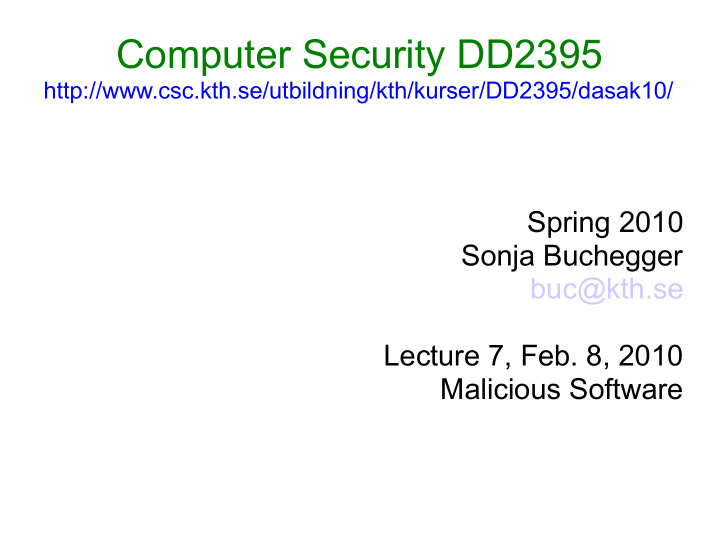



Computer Security DD2395 http://www.csc.kth.se/utbildning/kth/kurser/DD2395/dasak10/ Spring 2010 Sonja Buchegger buc@kth.se Lecture 7, Feb. 8, 2010 Malicious Software
Malicious Software programs exploiting system vulnerabilities known as malicious software or malware program fragments that need a host program e.g. viruses, logic bombs, and backdoors independent self-contained programs e.g. worms, bots replicating or not sophisticated threat to computer systems Feb. 8, 2010 KTH DD2395 Sonja Buchegger 2
Malware Terminology Virus Worm Logic bomb Trojan horse Backdoor (trapdoor) Mobile code Auto-rooter Kit (virus generator) Spammer and Flooder programs Keyloggers Rootkit Zombie, bot Feb. 8, 2010 KTH DD2395 Sonja Buchegger 3
Viruses piece of software that infects programs modifying them to include a copy of the virus so it executes secretly when host program is run specific to operating system and hardware taking advantage of their details and weaknesses a typical virus goes through phases of: dormant propagation triggering execution Feb. 8, 2010 KTH DD2395 Sonja Buchegger 4
Virus Structure components: infection mechanism - enables replication trigger - event that makes payload activate payload - what it does, malicious or benign prepended / appended / embedded when infected program invoked, executes virus code then original program code can block initial infection (difficult) or propagation (with access controls) Feb. 8, 2010 KTH DD2395 Sonja Buchegger 5
Virus Structure Feb. 8, 2010 KTH DD2395 Sonja Buchegger 6
Compression Virus Feb. 8, 2010 KTH DD2395 Sonja Buchegger 7
Virus Classification boot sector file infector macro virus encrypted virus stealth virus polymorphic virus metamorphic virus Feb. 8, 2010 KTH DD2395 Sonja Buchegger 8
Macro Virus became very common in mid-1990s since platform independent infects documents is easily spread exploit macro capability of office apps executable program embedded in office doc often a form of Basic more recent releases include protection recognized by many anti-virus programs Feb. 8, 2010 KTH DD2395 Sonja Buchegger 9
E-Mail Viruses more recent development e.g. Melissa exploits MS Word macro in attached doc if attachment opened, macro activates sends email to all on users address list and does local damage then saw versions triggered reading email hence much faster propagation Feb. 8, 2010 KTH DD2395 Sonja Buchegger 10
Recommend
More recommend